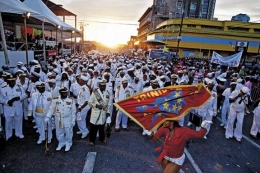Dr. Kim Johnson discusses the sailor mas’ protrayal of the Trinidad All Stars Steel Orchestra and the origins of this style of masquerade from the independent organizations of the enslaved in nineteenth century Trinidad. Caribbean Beat Magazine, issue 113.
The Fleet’s In sailor mas might seem just a grown-up way of enjoying Carnival with a great steelband, Trinidad All Stars. Actually, it’s much more than that. It is a venerable tradition of the oldest steel orchestra in the world, a tradition that links us to the world the slaves made, and, through them, to the culture of West Africa.
Trinidad All Stars was once “Cross of Lorraine” and before that “Fisheye band”, and even before that, during World War II, “Second Fiddle”. When, in 1939, it was launched in the immediate wake of the first progenitive steelband, Alexander’s Ragtime Band, however, it was simply called “Hell Yard band”, after Hell Yard, an empty lot next to the band’s current home.
In the early, pre-steelband years of the twentieth century the Hell Yard crew played cricket and football. They gambled, wrestled, boxed and lifted weights. And on J’Ouvert morning they produced one of the most famous sailor bands: USS Bad Behaviour.
There were other themes in plebeian mas in Port of Spain: African Ju Ju warriors and wild Indian tribes, for instance. But generally the largest bands, which represented each district of the city, were sailor bands. There were the immaculate, rigorously drilled military sailor bands, such as the USS Oregon from John John, Texas from Laventille, and Hit The Deck from St Paul’s Street. And there were the dirty “knockabout” sailor bands, such as USS Bad Behaviour, which was drunk, dirty and disorderly – like real sailors ashore.
No one knows Bad Behaviour’s age, but sailor bands have been around for at least a century. In 1911 traditional “masks”, according to the Port of Spain Gazette, included wild Indians, bakers, Barbadian cooks, clowns, devils and sailors. Military bands go back even further. In 1834, describing the first Carnival after abolition of slavery, the Gazette complained of “a large crowd of idle negroes and little people, accompanying a party intending to represent the Artillery.”
Scrupulously observing the minutiae of naval or military ranks, such bands catered to the needs of African slaves to found their own social and ritual hierarchies. They were worlds complete with their own divisions of labour, ranks, chains of command and degrees of prestige, all outside and independent of the grinding racism of the wider, white-dominated society.
They were descended from Trinidad’s slave convoys or regiments, groups dedicated to holding dances on holidays. These – the Cocorite, the Macaque, the St George and the Sans-peur, with up to 17 different ranks, kings, queens, princes and political, legal and military personnel – terrified the whites in 1805. They considered the bands insurrectionary, and cruelly punished their members.
The vicious reaction of the whites was a product of their own hysteria, of course; the slave gangs were formed for nothing more than to hold drum dances and compete against one another. But in another sense, the slave owners’ instinctive fear had grounds, because those bands, built on rules and responsibilities independent of the slave society’s, were forged from no less than the love of liberty.
For original post: Trinidad All Stars: Fleet’s In | Caribbean Beat Magazine.
